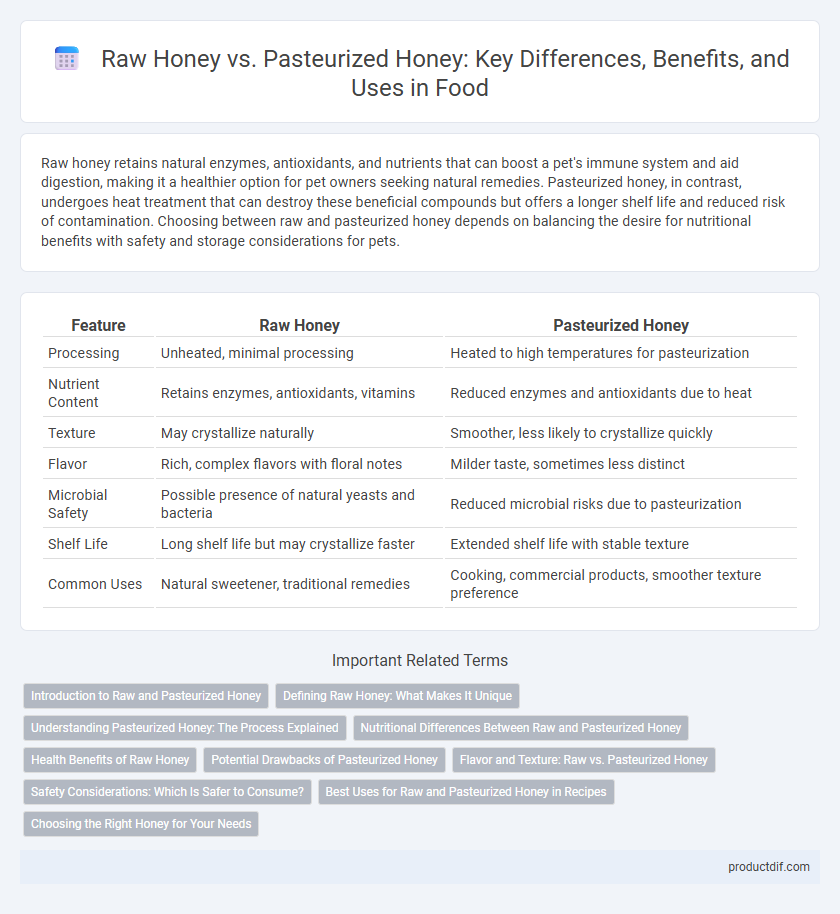Raw honey retains natural enzymes, antioxidants, and nutrients that can boost a pet's immune system and aid digestion, making it a healthier option for pet owners seeking natural remedies. Pasteurized honey, in contrast, undergoes heat treatment that can destroy these beneficial compounds but offers a longer shelf life and reduced risk of contamination. Choosing between raw and pasteurized honey depends on balancing the desire for nutritional benefits with safety and storage considerations for pets.
Table of Comparison
| Feature | Raw Honey | Pasteurized Honey |
|---|---|---|
| Processing | Unheated, minimal processing | Heated to high temperatures for pasteurization |
| Nutrient Content | Retains enzymes, antioxidants, vitamins | Reduced enzymes and antioxidants due to heat |
| Texture | May crystallize naturally | Smoother, less likely to crystallize quickly |
| Flavor | Rich, complex flavors with floral notes | Milder taste, sometimes less distinct |
| Microbial Safety | Possible presence of natural yeasts and bacteria | Reduced microbial risks due to pasteurization |
| Shelf Life | Long shelf life but may crystallize faster | Extended shelf life with stable texture |
| Common Uses | Natural sweetener, traditional remedies | Cooking, commercial products, smoother texture preference |
Introduction to Raw and Pasteurized Honey
Raw honey is extracted directly from honeycombs and retains natural enzymes, antioxidants, and nutrients, offering a richer flavor and potential health benefits. Pasteurized honey undergoes heat processing to eliminate yeast and delay crystallization, which extends shelf life but may reduce nutrients and alter taste. Understanding the differences between raw and pasteurized honey helps consumers select options based on nutritional value and culinary uses.
Defining Raw Honey: What Makes It Unique
Raw honey is unprocessed and extracted directly from the honeycomb, retaining natural enzymes, antioxidants, and pollen that contribute to its unique nutritional benefits. Unlike pasteurized honey, it is not heated above 95degF (35degC), preserving its natural flavor, aroma, and therapeutic properties. This minimal processing ensures raw honey maintains its antibacterial and anti-inflammatory qualities, making it distinct from commercially processed varieties.
Understanding Pasteurized Honey: The Process Explained
Pasteurized honey undergoes a heating process typically between 140degF and 160degF (60degC to 71degC) to kill yeast cells and prevent fermentation, enhancing shelf life and clarity. This thermal treatment can reduce the honey's natural enzymes, antioxidants, and pollen content, affecting its nutritional and therapeutic properties. Understanding the pasteurization process helps consumers make informed choices between raw honey's natural benefits and the extended shelf stability of pasteurized honey.
Nutritional Differences Between Raw and Pasteurized Honey
Raw honey retains more natural enzymes, antioxidants, vitamins, and minerals due to minimal processing, enhancing its nutritional profile compared to pasteurized honey. Pasteurization involves heating honey to high temperatures, which can degrade heat-sensitive nutrients and reduce beneficial enzymes like glucose oxidase. Studies indicate raw honey has higher levels of phenolic compounds and antibacterial properties, contributing to better health benefits than pasteurized varieties.
Health Benefits of Raw Honey
Raw honey contains natural enzymes, antioxidants, and antibacterial compounds that promote digestion, boost the immune system, and heal wounds more effectively than pasteurized honey. Pasteurization involves heating honey, which can degrade its beneficial nutrients and enzymes, reducing its therapeutic properties. Consuming raw honey supports gut health and provides anti-inflammatory effects, making it a superior choice for natural healing and overall wellness.
Potential Drawbacks of Pasteurized Honey
Pasteurized honey undergoes heat treatment that can reduce its natural enzymes, vitamins, and antioxidants, diminishing its nutritional value compared to raw honey. The heating process may also alter the honey's flavor profile and degrade beneficial compounds such as pollen and propolis. This reduction in bioactive components can impact the overall health benefits typically associated with raw honey consumption.
Flavor and Texture: Raw vs. Pasteurized Honey
Raw honey retains its natural enzymes, pollen, and antioxidants, giving it a richer, more complex flavor and a thicker, creamier texture compared to pasteurized honey. Pasteurized honey undergoes heat treatment that smooths its consistency but often diminishes subtle floral notes and reduces beneficial nutrients. The distinct texture and depth of flavor in raw honey make it preferred for culinary uses that emphasize natural sweetness and enhanced mouthfeel.
Safety Considerations: Which Is Safer to Consume?
Raw honey contains natural enzymes and antioxidants but may carry a risk of bacterial contamination, including Clostridium botulinum spores, posing dangers especially to infants under one year old. Pasteurized honey undergoes heat treatment to eliminate potential pathogens, reducing microbial risks and extending shelf life, but this process can diminish some beneficial nutrients. For most adults, pasteurized honey offers a safer option due to minimized contamination, while raw honey requires cautious consumption and is best avoided by vulnerable populations.
Best Uses for Raw and Pasteurized Honey in Recipes
Raw honey, with its rich enzymes and floral flavors, excels in dishes that benefit from natural sweetness and health-boosting properties, such as salad dressings, smoothies, and drizzle over yogurt or toast. Pasteurized honey, having a smoother texture and milder taste due to heat treatment, is ideal for baking recipes like cookies and cakes where consistent sweetness and longer shelf stability are important. Using raw honey in uncooked dishes preserves its antioxidants, while pasteurized honey's stability makes it preferable for high-temperature cooking and commercial food production.
Choosing the Right Honey for Your Needs
Raw honey contains natural enzymes, antioxidants, and pollen that offer health benefits, while pasteurized honey is heated to kill yeast and extend shelf life but may lose some nutrients. Choosing the right honey depends on your needs: raw honey is ideal for immune support and natural remedies, whereas pasteurized honey suits those seeking a smoother texture and longer storage. Always check labels for purity and origin to ensure quality and authenticity.
Raw honey vs Pasteurized honey Infographic

 productdif.com
productdif.com